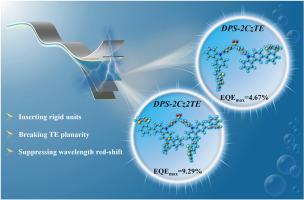合理插入外围刚性单元,构建高效溶液处理oled的基于噻吩的蓝色TADF发射器
IF 4.2
3区 工程技术
Q2 CHEMISTRY, APPLIED
引用次数: 0
摘要
尽管有许多关于二苯基砜基热激活延迟荧光(TADF)发射器的研究,但在外围插入刚性单元以实现蓝色发射的策略很少报道。本文引入一种新的刚性给体,即噻吩基团,合成了两种新型的蓝色发射TADF材料:DPS-2CzTE和DPS-2Cz2TE。二苯基砜单元分别作为电子受体(A)和咔唑衍生物作为电子给体(D)。多个给体导致a -d -d '结构高度扭曲,并增强了电子给体能力,从而有助于实现更高的反向系统间交叉(RISC)速率和抑制聚集引起的猝灭(ACQ)效应。通过在咔唑基团中插入刚性噻吩单元,增加了分子间距离,有效地缓解了波长的大红移,有效地打破了其平面性。正如预期的那样,与已报道的分别由柔性单元和叔丁基咔唑单元修饰的发射体(POCz-DPS和2CzSO)相比,所得到的发射体表现出55 nm的蓝移发射峰。通过调节外围噻吩基团的数量,基于DPS-2Cz2TE的溶液处理器件的性能比DPS-2CzTE提高了近两倍,达到了9.29%的最大外量子效率(EQEmax)。本研究证明了选用噻吩作为刚性基团修饰TADF发射体的可行性,为溶液处理有机发光二极管中高效蓝色TADF发射体的设计提供了重要参考。本文章由计算机程序翻译,如有差异,请以英文原文为准。

Rational insertion of peripheral rigid units to construct thianthrene-based blue TADF emitters for highly efficient solution-processed OLEDs
In spite of numerous works about diphenylsulfone-based thermally activated delayed fluorescence (TADF) emitters, the strategy of inserting rigid units to the periphery to achieve blue emission are rarely reported. Herein, we introduce a novel rigid donor, the thianthrene group, we synthesized two novel blue-emitting TADF materials: DPS-2CzTE and DPS-2Cz2TE. The diphenylsulfone unit acts as the electron acceptor (A) and the carbazole derivates act as the electron donors (D), respectively. The multiple donors result in a highly twisted A-D-D’ architecture and enhanced electron-donating capabilities, which facilitate achieving a higher reverse intersystem crossing (RISC) rate and suppressed aggregation-caused quenching (ACQ) effect. By inserting rigid thianthrenes unit into the carbazole group, the intermolecular distance was increased, effectively alleviating the large red-shift of the wavelength and breaking its planarity availably. As expected, the resulting emitters exhibited a 55 nm blue-shifted emission peak compared to reported emitters (POCz-DPS and 2CzSO) which are modified by flexible units and tert-butyl carbazole units, respectively. By regulating the number of peripheral thianthrene groups, the performance of solution-processed devices based on DPS-2Cz2TE has been improved by nearly twofold compared to DPS-2CzTE, achieving maximum external quantum efficiency (EQEmax) of 9.29 %. This work demonstrates the feasibility of selecting thianthrene as rigid groups to modify TADF emitters, and provides an important reference for the design of highly efficient blue TADF emitters in solution-processed organic light-emitting diodes.
求助全文
通过发布文献求助,成功后即可免费获取论文全文。
去求助
来源期刊

Dyes and Pigments
工程技术-材料科学:纺织
CiteScore
8.20
自引率
13.30%
发文量
933
审稿时长
33 days
期刊介绍:
Dyes and Pigments covers the scientific and technical aspects of the chemistry and physics of dyes, pigments and their intermediates. Emphasis is placed on the properties of the colouring matters themselves rather than on their applications or the system in which they may be applied.
Thus the journal accepts research and review papers on the synthesis of dyes, pigments and intermediates, their physical or chemical properties, e.g. spectroscopic, surface, solution or solid state characteristics, the physical aspects of their preparation, e.g. precipitation, nucleation and growth, crystal formation, liquid crystalline characteristics, their photochemical, ecological or biological properties and the relationship between colour and chemical constitution. However, papers are considered which deal with the more fundamental aspects of colourant application and of the interactions of colourants with substrates or media.
The journal will interest a wide variety of workers in a range of disciplines whose work involves dyes, pigments and their intermediates, and provides a platform for investigators with common interests but diverse fields of activity such as cosmetics, reprographics, dye and pigment synthesis, medical research, polymers, etc.
 求助内容:
求助内容: 应助结果提醒方式:
应助结果提醒方式:


